Love, Play, and Mail
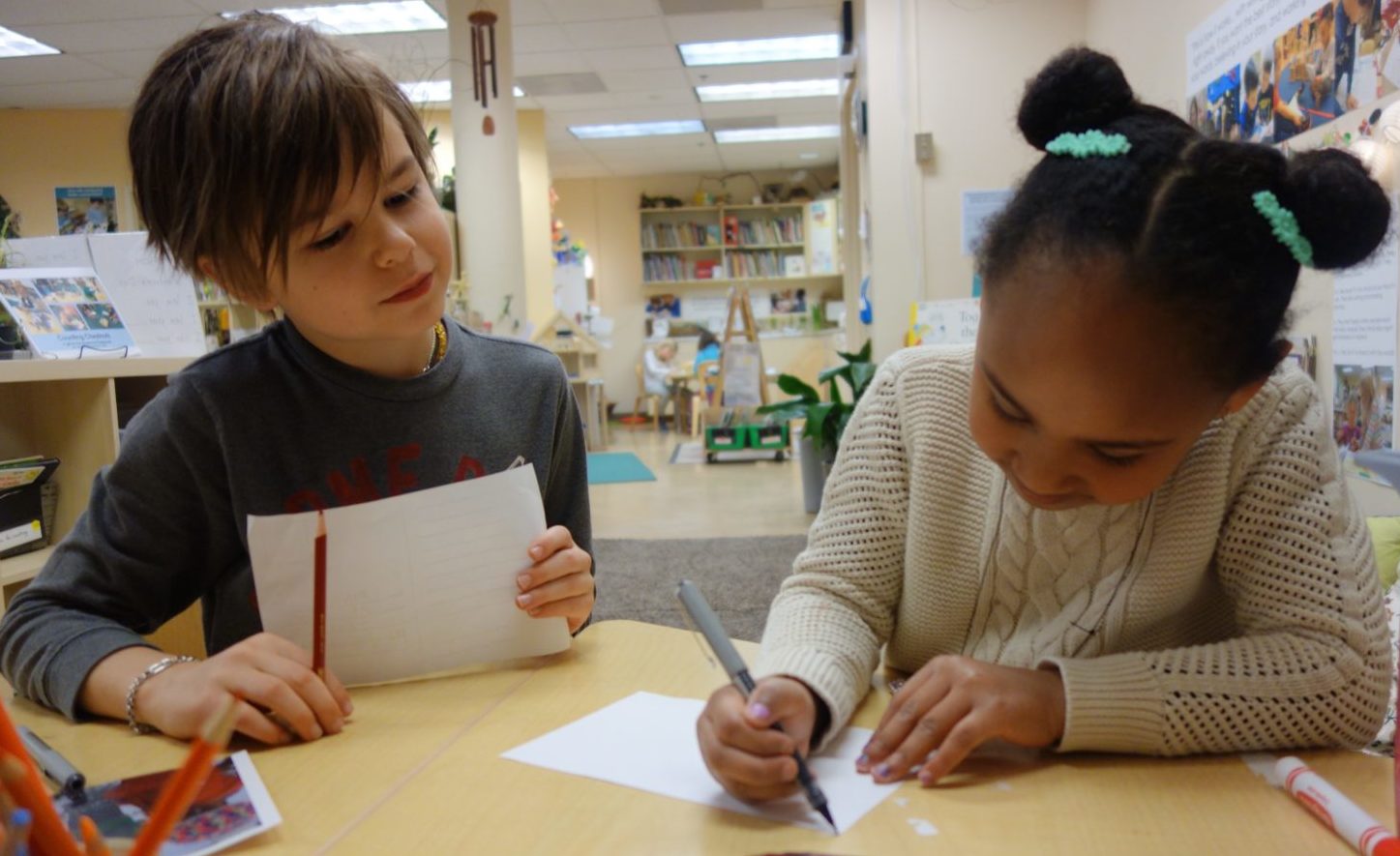
“In play, children begin with their own set of premises and learn to follow through, step-by-step, scene by scene in the complex process of creating a logical and literary dramatic project of their own.” – Vivian Paley, The Importance of Fantasy, Fairness, and Friendship in Children’s Play
The Cottonwood community of kindergarteners and first-graders has been exploring love and message writing, oftentimes finding overlaps and connections between the two through play. Love naturally came up near Valentine’s Day and the children’s interest in sharing love led us to crack the word open together, go to materials to uncover what happens inside our bodies when we experience love, give love or have love, and create inventions to help others share, offer, receive, or understand love. Simultaneously, we began a genre study during Story Workshop on message writing stemming some from the excitement the children had about sharing notes with each other on Valentine’s Day and partially due to their curiosity in the postcard we sent with their published stories into the Little Free Library.
In the initial days of the genre study, we watched and listened, the children showed us how they were using message writing as a language to share love.
Derek: I want to write to my brother so he knows I love him.
Isaac: I’m going to write another message to Jennifer so she knows I love her.
Sydney: I’m going to write to my Dad. He’s on a work trip right right now. I miss him and love him.
Amanda: This is what happens when you feel love. The mail person gives a letter and then the other person takes it and they feel love inside. It feels good. It makes you want to get even more mail!
Mail for each other continued to accumulate in the classroom. As teachers, we noticed that children were writing messages to each other and delivering them immediately, in person. However, when unexpected things happened (such as a child being absent) or we needed to deliver mail outside of Cottonwood, we often got stuck, very stuck. Children who were absent shared that, when they returned to school, friends would tell them that they had put mail inside their cubbies or by their backpacks outside, but that they couldn’t find it. Similarly, we were unable to deliver mail to people in other classrooms as we finished letters, which led us to misplacing mail, delivering it to the recipient days later, or losing it.
These natural problems led us to wonder: What system will support Cottonwood to reliably send mail out into the world and receive mail back?
As Vivian Paley writes above, we knew that play was the best way for the children to explore the problems inherent in our lack of system and come up with new possibilities for moving forward. During Dramatic Play, many ideas surfaced.
A few children collaborated on including incoming and outgoing mail slots, inspired by the mail baskets they saw in a photo of the museum’s office. These children used tape and construction paper to build the slots, labeled them “incoming” and “outgoing,” and hung the slots outside of Cottonwood. Another partnership made a zip line using wire, tape, string, and part of an egg carton as a mail carrying basket. The zip line ran from Cottonwood to the Willow classroom (fourth and fifth grade) and served as a tool for getting mail to our older Reading Buddies, and a destination outside of Cottonwood.
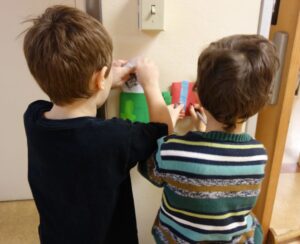
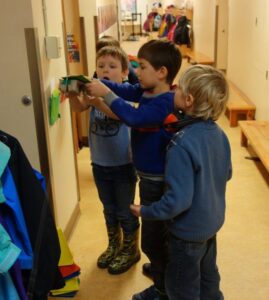
We noticed the children trying out these systems and running into new tangles. For example, some children had mail sitting in the incoming slot for days without knowing it. Eventually, our incoming slot got so full that it fell off the wall! Also, we put mail in the outgoing slot but, without a system for dispersing it from there, our mail rarely got to its destination. Similarly, although the zip line worked well for Willow (because their room is right next door to us) it was not transferable to other classrooms. How might we get mail to the Dogwood Community, for example, who is all the way upstairs?
As teachers, we wondered what resources we might bring to the children that would offer new information for them to interpret, play with, and apply to their own mail system. We decided to leave a message for the museum’s letter carrier, Kevin, and see if we could meet with him. Kevin agreed and before his visit, the children spent time thinking about the questions they had for him. As a community we wondered: What additional information about the mail system might support us in delivering and receiving mail in Cottonwood?
When Kevin visited we were prepared with our research questions!
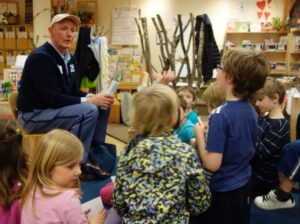
Christian: How does the mail system work?
Kevin: The mail service is so big. Trucks, sorters downtown, people like me who carry it. Basically when you mail something someone like me picks it up and we organize [the mail] into bundles that go to people who will process it. There are lots of hands that hold the mail.
Lauren: (pulling from children’s words) Where does mistake mail go?
Kevin: There’s an office where we have people dedicated to trying to look for the right owners! Sometimes people get the address or name wrong or something else wrong and we can’t send it back. There’s an office full of mail that sits there. There are people that try to look up the addresses. Sometimes they find them and sometimes they don’t.
Isaac: What if you don’t know the street you have to go to?
Kevin: I have maps and someone I can call if I get lost during the day.
Chloe: How fast do the mail [people] go?
Kevin: Sometimes we go pretty fast! I’m on a tight schedule. So when I start here at the museum I’m usually only here for only a minute or two!
Micah: What do mail planes look like?
Kevin: Now we use commercial flights like the planes you all might ride when you go on vacation. There might be a bag of mail in the cargo hold while you are flying…like a big sack of paper!
Kevin’s visit left us with a significant amount of new information. We knew that the most natural way for the children to explore, interpret, and apply this information, as Vivian Paley suggests above, was through play. A donation from one of our families allowed us to add a blue hat and bag to dramatic play. Lauren added small boxes, envelopes, and other packaging supplies. During explore we observed the children playing with these new materials and wondered what knots in our Cottonwood mail system the children might untangle.
Inspired by the new materials, the children built their idea of a post office and one child dressed up to deliver mail to a family who lived in a nearby home. We noticed the children playing with some of the ideas Kevin had shared with us earlier. For example, Ryder found a package that had not been addressed correctly in his mail bag and could not deliver it. He had to put it back inside his bag to take care of later. Abigail and Anne also sorted out the jobs of the post office. Anne exclaimed, “We need more than one worker! It’s too much for just one person.” And then William added, “One guy can’t do the mail all by himself…wait! I can be the deliverer. Abigail can be the post office person. And Anne drives Kevin in the car. She’s the driver!”
The children also progressed towards a more comprehensive idea of a mail slot. Ryder asked William to make a mail slot for him with paper. However, instead of recreating our old model with construction paper, William returned with a cardboard box that he had labeled as the mailbox and described it as, “a package that you can fit more mail inside.”
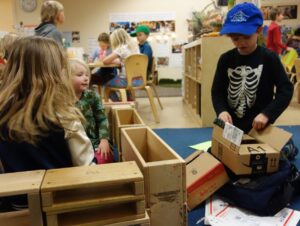
While the children in dramatic play were uncovering more about our mail system, a small group met in the studio to think about mail slots. What could we do to make sure that our incoming and outgoing mail slots do not overfill again? What changes do we need to make to ensure that mail gets taken out of the slots and delivered? Where will our mail within Cottonwood go so that we each get out mail?
The children decided that one slot for all of our classroom’s mail was not enough and, instead, each person needed their own mail box. The children worked with cardboard and glue to create prototypes for each member of the Cottonwood community.
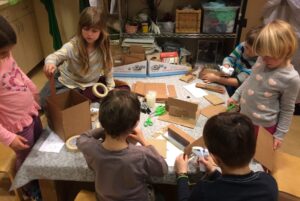
Earlier in the week, parents came in for a Project Work Curriculum Night and we asked and collected families projections, resources and ideas around project work. Just days later, Lauren and I looked over all our data (including children’s unanswered questions, Kevin’s shared information, the children’s dialog from Dramatic Play, and conversations that happened around the exchange of mail) and we talked about what we imagined our communities project work possibilities to be as we moved forward toward the end of the year.
Moving forward, Lauren and I are wondering what might happen when this group presents their mailbox prototypes to the rest of the community. Specifically, what connections might the group from dramatic play have to the idea of needing something larger than a paper envelope to hold our mail? What new tangles will we run into as we try out these mailbox prototypes? How might play help us to imagine new possibilities for problem solving these tangles as a community? How else might we incorporate interviewing into the work to research what other classrooms need? What possibilities for collaboration, deeper connections, and appreciation of one another’s gifts and our gifts when we work as a whole, are inherent within this project work?
-How is play driving project work in your classroom?
-What do you notice when you observe the children engaged in play? What tangles are they encountering and what possibilities are they finding that enable you to move forward in playful inquiry?
